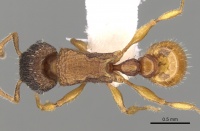Tetramorium fuscipes
| Tetramorium fuscipes | |
|---|---|

| |
| Scientific classification | |
| Kingdom: | Animalia |
| Phylum: | Arthropoda |
| Class: | Insecta |
| Order: | Hymenoptera |
| Family: | Formicidae |
| Subfamily: | Myrmicinae |
| Tribe: | Crematogastrini |
| Genus: | Tetramorium |
| Species: | T. fuscipes |
| Binomial name | |
| Tetramorium fuscipes (Viehmeyer, 1925) | |
Besides a collection record noting a specimen found under a stone in dry sclerophyll, nothing is known about the biology of Tetramorium fuscipes.
Identification
Although originally described as a subspecies of Tetramorium turneri this species is distinct and consistently smaller, lighter in colour and more densely sculptured.
This is one of the Australian species which I suspect may be an aggregate, with two or more sibling species concealed by a mass of variable characters. Variation within fuscipes as defined above relates to size, sculpture, impression of metanotal groove, spine length and slight differences in petiole shape. Many of these features do not appear to have any geographical significance (at least not among the few series examined) but one character may be significant, that is the sculpturation, or lack of it, upon the postpetiole. It appears that specimens from the northern end of the range usually have traces of postpetiolar sculpture whilst more southerly samples do not.
Keys including this Species
Distribution
Latitudinal Distribution Pattern
Latitudinal Range: -16.925397° to -34.031432°.
| North Temperate |
North Subtropical |
Tropical | South Subtropical |
South Temperate |
- Source: AntMaps
Distribution based on Regional Taxon Lists
Australasian Region: Australia (type locality).
Distribution based on AntMaps
Distribution based on AntWeb specimens
Check data from AntWeb
Countries Occupied
| Number of countries occupied by this species based on AntWiki Regional Taxon Lists. In general, fewer countries occupied indicates a narrower range, while more countries indicates a more widespread species. |

|
Estimated Abundance
| Relative abundance based on number of AntMaps records per species (this species within the purple bar). Fewer records (to the left) indicates a less abundant/encountered species while more records (to the right) indicates more abundant/encountered species. |

|
Biology
Castes
Nomenclature
The following information is derived from Barry Bolton's Online Catalogue of the Ants of the World.
- fuscipes. Xiphomyrmex turneri subsp. fuscipes Viehmeyer, 1925a: 29 (w.) AUSTRALIA. Combination in Tetramorium: Bolton, 1977: 138. Raised to species: Bolton, 1977: 138.
Unless otherwise noted the text for the remainder of this section is reported from the publication that includes the original description.
Description
Worker
Bolton (1977) - TL 2.8-3.1, HL 0.64-0.72, HW 0.58-0.68, CI 90-94, SL 0.44-0.50, SI 72-78, PW 0.46-0.56, AL 0.76-0.88 (10 measured).
Mandibles weakly longitudinally striate, the anterior clypeal margin without a notch medially. Frontal carinae strong and extending back almost to the occiput, forming the dorsal margins of the broad but shallow scrobes. Scrobes as long as the antennal scapes but not deep enough to accommodate them fully. Eyes at the midlength of the sides of the head. Alitrunk in profile with the metanotal groove variously impressed, in most specimens not or only feebly marked but in a few very distinctly impressed. This feature shows much variation in the single nest-series in which it was found (Queensland, Sunnybank). Propodeal spines moderately long, acute; metapleural lobes long, narrow-triangular, acute and feebly upcurved. Petiole in dorsal view at least as long as broad, usually longer than broad. Dorsum of head regularly and quite densely longitudinally rugulose, the spaces between the rugulae packed with a dense, conspicuous reticulate-puncturation. Cephalic rugulae anastomosing or with reticulation on the occipital surface. Dorsal alitrunk reticulate-rugulose, most coarsely so on the pronotum, the spaces filled with puncturation as on the head. Dorsum of petiole unsculptured medially or with a few fine rugulae, the puncturation usually absent; the postpetiole usually smooth and polished, rarely with faint shagreening or puncturation. Gaster smooth and shining. All dorsal surfaces of the head and body with numerous erect to suberect long hairs, those of the alitrunk and pedicel generally blunted apically. Colour yellowish brown, the legs and sometimes also the gaster lighter than the alitrunk. Head always much darker than the remainder, brown to dark brown, this colour contrast distinct to the naked eye.
Type Material
Bolton (1977) - Syntype workers, Australia: New South Wales, Liverpool (Naturhistorisches Museum, Basel) [examined]. The published name of this species is as above but the name on the det. label of the syntypes is fusciceps, which is more appropriate as the head is dark and is probably the name originally intended by Viehmeyer. However, the above published name must stand, despite the fact that the legs are yellow and not infuscated.
- Syntype, worker(s), Liverpool, New South Wales, Australia, Berlin Museum für Naturkunde der Humboldt-Universität.
References
- Bolton, B. 1977. The ant tribe Tetramoriini (Hymenoptera: Formicidae). The genus Tetramorium Mayr in the Oriental and Indo-Australian regions, and in Australia. Bulletin of the British Museum (Natural History). Entomology. 36:67-151. (page 138, Combination in Tetramorium, and raised to species.)
- Viehmeyer, H. 1925a. Formiciden der australischen Faunenregion. (Fortsetzung.). Entomol. Mitt. 14: 25-39 (page 29, worker described)
References based on Global Ant Biodiversity Informatics
- Bolton, B. "The ant tribe Tetramoriini (Hymenoptera: Formicinae. The genus Tetramorium Mayr in the Oriental and Indo-Australian regions and in Australia." Bulletin of the British Museum (National History): Entomology series 36, no. 2 (1977): 68-151.

